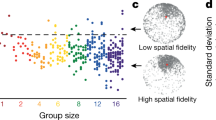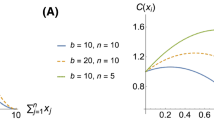Abstract
Empirical evidence suggests that division of labor in insect societies is positively related to group size both within and across taxa. Response threshold models (RTM) have been commonly used to analyze patterns of division of labor. However, these models have been explored empirically and theoretically for only a limited number of tasks, and few studies have examined predictions of the model as colony size and work availability change. We theoretically examine how group size influences division of labor using a fixed response-threshold model. We simultaneously explore how expected by-products of increased colony size, including demand (total work need relative to total work force available) and task number, affect this relationship. Our results indicate that both low demand and high task number positively influence division of labor. We suggest that these changes parallel what is observed within social groups as their size increases, and that, in part, the commonly observed increased division of labor with increasing group size is emergent.



Similar content being viewed by others
References
Anderson C (2001) The adaptive value of inactive foragers and the scout-recruit system in honey bee (Apis mellifera) colonies. Behav Ecol 12:111–119
Anderson C, Ratnieks FLW (1999) Task partitioning in insect societies. I. Effect of colony size on queueing delay and colony ergonomic efficiency. Am Nat 154:521–535
Anderson C, McShea D (2001) Individual versus social complexity, with particular reference to ant colonies. Biol Rev 76:211–237
Arathi HS, Spivak M (2001) Influence of colony genotypic composition on the performance of hygienic behaviour in the honeybee, Apis mellifera L. Anim Behav 62:57–66
Beekman M, Sumpter DJT, Ratnieks FLW (2001) Phase transition between disordered and ordered foraging in Pharaoh’s ants. Proc Natl Acad Sci U S A 98:9703–9706
Bell G, Mooers AO (1997) Size and complexity among multicellular organisms. Biol J Linn Soc 60:345–363
Beshers SN, Fewell JH (2001) Models of division of labor in social insects. Ann Rev Entomol 46:413–440
Bonabeau E, Theraulaz G, Deneubourg J-L (1996) Quantitative study of the fixed threshold model for the regulation of division of labour in insect societies. Proc R Soc Lond B 263:1565–1569
Bonabeau E, Theraulaz G, Deneubourg JL (1998) Fixed response thresholds and the regulation of division of labor in insect societies. Bull Math Biol 60:753–807
Bonner JT (1993) Dividing the labor in cells and societies. Curr Sci 64:459–466
Bonner JT (1998) The origins of multicellularity. Integr Biol 1:27–36
Bonner JT (2004) Perspective: The size-complexity rule. Evolution 58:1883–1890
Boomsma JJ, Ratnieks FLW (1996) Paternity in eusocial hymenoptera. Philos Trans R Soc Lond B 351:947–975
Bourke AFG (1999) Colony size, social complexity and reproductive conflict in social insects. J Evol Biol 12:245–257
Cole BJ (1983) Multiple mating and the evolution of social behavior in the Hymenoptera. Behav Ecol Sociobiol 12:191–201
Darchen R (1964) Biologie des Vespa orientalis. Les premiers stades de développement. Insectes Soc 2:141–158
Detrain C, Pasteels JM (1991) Caste differences in behavioral thresholds as a basis for polyethism during food recruitment in the ant, Pheidole pallidula (Nyl) (Hymenoptera, Myrmicinae). J Ins Behav 4:157–176
Detrain C, Pasteels JM (1992) Caste polyethism and collective defense in the ant, Pheidole pallidula—the outcome of quantitative differences in recruitment. Behav Ecol Sociobiol 29:405–412
Fernandez-Marin H, Zimmermann JK, Wcislo WT (2003) Nest-founding in Acromyrmex octospinosus (Hymenoptera, Formicidae, Attini): demography and putative prophylactic behaviors. Insectes Soc 50:304–308
Fewell JH, Page RE (2000) Colony-level selection effects on individual and colony foraging task performance in honeybees, Apis mellifera L. Behav Ecol Sociobiol 48:173–181
Fjerdingstad EJ, Crozier RH (2006) The evolution of worker caste diversity in social insects. Am Nat 167:390–400
Franks NR, Deneubourg J-L (1997) Self-organizing nest construction in ants: individual worker behaviour and the nest’s dynamics. Anim Behav 54:779–796
Gautrais J, Theraulaz G, Deneubourg JL, Anderson C (2002) Emergent polyethism as a consequence of increased colony size in insect societies. J Theor Biol 215:363–373
Gorelick R, Bertram SM, Killeen PR, Fewell JH (2004) Normalized mutual entropy in biology: quantifying division of labor. Am Nat 164:678–682
Jeanne RL (1991a) Polyethism. In: Ross KG Matthews RW (eds) The social biology of wasps Cornell University Press Ithaca, New York , pp 389 – 425
Jeanne RL (1991b) The swarm-founding Polistinae. In: Ross KG, Matthews RW (eds) The social biology of wasps. Cornell University Press, Ithaca, New York, pp 191– 231
Jeanson R, Kukuk PF, Fewell JH (2005) Emergence of division of labour in halictine bees: contributions of social interactions and behavioural variance. Anim Behav 70:1183–1193
Jones JC, Myerscough MR, Graham S, Oldroyd BP (2004) Honey bee nest thermoregulation: diversity promotes stability. Science 305:402–404
Karsai I, Wenzel JW (1998) Productivity, individual-level and colony-level flexibility, and organization of work as consequences of colony size. Proc Natl Acad Sci U S A 95:8665–8669
Kolmes SA (1985) A quantitative study of the division of labor among worker honey bees. Z Tierpsychol 68:287–302
Kolmes SA, Winston ML (1988) Division of labor among worker honey bees in demographically manipulated colonies. Insectes Soc 35:262–270
Lachaud J-P, Fresneau D (1987) Social regulation in ponerine ants. In: Deneubourg JL, Pasteels J (eds) From individual to collective behavior in social insects, 54. Birkhäuser-Verlag, Basel, pp 197– 217
Mailleux AC, Deneubourg JL, Detrain C (2003) How does colony growth influence communication in ants? Insectes Soc 50:24–31
McCarthy MC, Enquist BJ (2005) Organismal size, metabolism and the evolution of complexity in metazoans. Evol Ecol Res 7:681–696
Merkle D, Middendorf M (2004) Dynamic polyethism and competition for tasks in threshold reinforcement models of social insects. Adapt Behav 12:251–262
Meudec M (1979) Le comportement d’émigration chez la fourmi Tapinoma erraticum (Dolichoderinae): un exemple de régulation sociale. Bull Biol Fr Belg 13:321–374
Michener CD (1974) The social behavior of the bees. A comparative study. Belknap Press of Harvard University Press, Cambridge, MA
Murakami T, Higashi S, Windsor D (2000) Mating frequency, colony size, polyethism and sex ratio in fungus-growing ants (Attini). Behav Ecol Sociobiol 48:276–284
Myerscough MR, Oldroyd BP (2004) Simulation models of the role of genetic variability in social task allocation. Insectes Soc 51:146–152
Naug D (2001) Ergonomic mechanisms for handling variable amounts of work in colonies of the wasp Ropalidia marginata. Ethology 107:1115–1123
Naug D, Gadagkar R (1999) Flexible division of labor mediated by social interactions in an insect colony—a simulation model. J Theor Biol 197:123–133
O’Donnell S (1995) Division of labor in postemergence colonies of the primitively eusocial wasp Polistes instabilis De Saussure (Hymenoptera, Vespidae). Insectes Soc 42:17–29
O’Donnell S (1998) Dominance and polyethism in the eusocial wasp Mischocyttarus mastigophorus (Hymenoptera: Vespidae). Behav Ecol Sociobiol 43:327–331
Oldroyd BP, Fewell JH (2007) Genetic diversity promotes homeostasis in insect colonies. Trends Ecol Evol 22:408–413
Oster GF, Wilson EO (1978) Caste and Ecology in the Social Insects. Princeton University Press, Princeton, New Jersey
Pacala SW, Gordon DM, Godfray HCJ (1996) Effects of social group size on information transfer and task allocation. Evol Ecol 10:127–165
Page RE, Mitchell SD (1998) Self-organization and the evolution of division of labor. Apidologie 29:171–190
Pankiw T, Page RE (2000) Response thresholds to sucrose predict foraging division of labor in honeybees. Behav Ecol Sociobiol 47:265–267
Plowright RC, Plowright CMS (1988) Elitism in social insects: a positive fed-back model. In: Jeanne RL (ed) Interindividual behavioral variability in social insects. Westview Press, Boulder, CO, pp 419– 431
Robinson GE, Page RE (1988) Genetic determination of guarding and undertaking in honey-bee colonies. Nature 333:356–358
Robinson GE, Page RE (1989) Genetic basis for division of labor in an insect society. In: Breed MD, Page RE (eds) The genetics of social evolution. Westview Press, Boulder, CO, pp 61 – 80
Schatz B (1997) Modalités de recherche et de la récolte alimentaire chez le fourmi Ectatomma ruidum Roger: flexibilités individuelle et collective. PhD Thesis. Université Paul Sabatier, Toulouse, pp 275
Seeley TD (1995) The wisdom of the hive. Harvard University Press, Cambridge, Massachusetts
Shannon CE (1948) A mathematical theory of communication. Bell Syst Tech J 27:379–423, 623–656
Stuart RJ, Page RE (1991) Genetic component to division of labor among workers of a Lepthoracine ant. Naturwissenschaften 78:375–377
Theraulaz G, Bonabeau E, Deneubourg J-L (1998) Response threshold reinforcement and division of labour in insect societies. Proc R Soc Lond B 265:327–332
Thomas ML, Elgar MA (2003) Colony size affects division of labour in the ponerine ant Rhytidoponera metallica. Naturwissenschaften 90:88–92
Traniello JFA (1978) Caste in a primitive ant: absence of age polyethism in Amblyopone. Science 202:770–772
Traniello JFA, Rosengaus RB (1997) Ecology, evolution and division of labour in social insects. Anim Behav 53:209–213
Waibel M, Floreano D, Magnenat S, Keller L (2006) Division of labour and colony efficiency in social insects: effects of interactions between genetic architecture, colony kin structure and rate of perturbations. Proc R Soc Lond B 273:1815–1823
Weidenmüller A (2004) The control of nest climate in bumblebee (Bombus terrestris) colonies: interindividual variability and self reinforcement in fanning response. Behav Ecol 15:120–128
Wilson EO (1976) Behavioral discretization and number of castes in an ant species. Behav Ecol Sociobiol 1:141–154
Wilson EO (1980) Caste and division of labor in leaf-cutter ants (Hymenoptera, Formicidae, Atta).1. The overall pattern in Atta sexdens. Behav Ecol Sociobiol 7:143–156
Wilson EO (1986) Caste and division of labor in Erebomyrma, a genus of dimorphic ants (Hymenoptera, Formicidae, Myrmicinae). Insectes Soc 33:59–69
Acknowledgements
We wish to thank B. Hölldobler and P. Kukuk for their helpful discussions and insights. We thank four anonymous referees for helpful comments regarding the manuscript. This research was supported by National Science Foundation grant number 0446415 awarded to JHF and SMB. RJ was supported by a post-doctoral grant from the Fyssen Foundation.
Author information
Authors and Affiliations
Corresponding author
Additional information
Communicated by J. Traniello
Rights and permissions
About this article
Cite this article
Jeanson, R., Fewell, J.H., Gorelick, R. et al. Emergence of increased division of labor as a function of group size. Behav Ecol Sociobiol 62, 289–298 (2007). https://doi.org/10.1007/s00265-007-0464-5
Received:
Revised:
Accepted:
Published:
Issue Date:
DOI: https://doi.org/10.1007/s00265-007-0464-5




